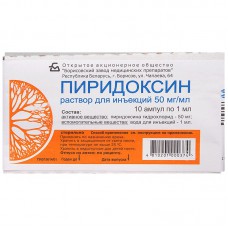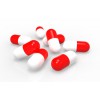Expiration date: 01/2026
Solution for injection
Composition
Active substance:
Pyridoxine hydrochloride – 10 mg or 50 mg.
Auxiliary substance:
Water for injection - up to 1 ml.
Description of the dosage form
Transparent colorless or slightly colored liquid.
Pharmacodynamics
Vitamin B6. Entering the body, it is phosphorylated, converted into pyridoxal-5-phosphate and is part of enzymes that carry out decarboxylation, transamination and racemization of amino acids, as well as enzymatic conversion of sulfur-containing and hydroxylated amino acids. Participates in tryptophan metabolism (participation in the serotonin biosynthesis reaction). Isolated pyridoxine deficiency is very rare, mainly in children on special artificial nutrition (manifested by diarrhea, seizures, anemia, peripheral neuropathy may develop).
Pharmacokinetics
It is metabolized in the liver to form pharmacologically active metabolites (pyridoxal phosphate and pyridoxaminophosphate). Pyridoxal phosphate binds to plasma proteins by 90%. Penetrates well into all tissues; accumulates mainly in the liver, less in the muscles and central nervous system. Penetrates through the placenta, secreted with breast milk. The half-life is 15-20 days. It is excreted by the kidneys (with intravenous administration - with bile 2%), as well as during hemodialysis.
Indications
Hypo- and vitamin deficiency B6 (treatment and prevention) — malnutrition, long-term infections, diarrhea, enteritis, sprue, prolonged stress, malabsorption syndrome, condition after removal of the stomach and large areas of the intestine, hemodialysis.
As part of complex therapy: congenital pyridoxine-dependent convulsive syndrome in newborns, prevention of seizures in patients while taking anti-tuberculosis drugs.
Contraindications
Hypersensitivity to pyridoxine hydrochloride.
With caution
Peptic ulcer of the stomach and duodenum, ischemic heart disease.
Use during pregnancy and lactation
The use of the drug during pregnancy and during breastfeeding is possible according to indications.
Method of administration and dosage
Parenterally (subcutaneously, intramuscularly or intravenously). The drug is injected if it is impossible to take it orally (with vomiting or with impaired absorption in the intestine).
Prevention. Adults - 2-5 mg / day, children from 0 months - 2 mg / day.
Treatment. Adults - 50-100 mg / day in 1-2 doses, children from 0 months - 20 mg. The course of treatment for adults is a month, for children 2 weeks.
With concomitant therapy with anti-tuberculosis drugs - 5-10 mg / day.
For the treatment of pyridoxine-dependent convulsive syndrome, adults - intravenously or intramuscularly - 30-600 mg; children from 0 months — 10-100 mg daily.
Side effects
Allergic reactions, hypersecretion of hydrochloric acid, numbness, the appearance of a feeling of compression in the extremities - a symptom of "stockings" and "gloves", decreased lactation (sometimes this is used as a therapeutic effect); convulsions (occur only with rapid administration).
Overdose
Symptoms. Metabolic disorders, manifested by the accumulation of lactic acid in the myocardium, muscles, liver and kidneys with a simultaneous decrease in their glycogen content.
The appearance of foci of baldness is possible.
It is possible to inhibit activity against the blood clotting system.
Treatment. The drug is canceled. Treatment is symptomatic. There is no special antidote.
Interaction
Pharmacologically incompatible with thiamine and cyanocobalamin.
Enhances the effect of diuretics; weakens the activity of levodopa.
Isoniazid, penicillamine; cycloserine and estrogen-containing oral contraceptives weaken the effect of pyridoxine.
Special instructions
Vitamin B6 is found in plants and animal organs, especially in raw grains of cereals, vegetables, meat, fish, milk, liver of cod and cattle, egg yolk. There is relatively a lot of vitamin B6 in yeast. The need for vitamin B6 is met by food: it is also partially synthesized by the intestinal microflora. The daily requirement for pyridoxine for adults is 2-2.5 mg; for children from 6 months to 1 year — 0.5 mg, 1-1.5 g - 0.9 mg; 1.5-2 years — 1 mg; 3-4 years - 1.3 mg; 5-6 years - 1.4 mg; 7-10 years - 1.7 mg; 11-13 years - 2 mg; for boys 14-17 years - 2.2 mg; for girls aged 14-17 years - 1.9 mg. For women - 2 mg and additionally 0.3 mg during pregnancy, 0.5 mg during breastfeeding. In severe liver damage, pyridoxine in large doses can cause deterioration of its function. When determining urobilinogen using the Ehrlich reagent, it may distort the results.
Influence on the ability to drive vehicles and manage mechanisms
During the treatment period, it is possible to drive vehicles and engage in potentially dangerous activities that require increased concentration of attention and speed of psychomotor reactions.
Release form
Solution for injection of 10 mg / ml, 50 mg / ml.
In ampoules of 1 ml or 2 ml.
10 ampoules are placed in a cardboard box with corrugated partitions.
5 ampoules are placed in a contour cell packaging made of polyvinyl chloride film.
2 contour cell packages are placed in a pack of cardboard.
Instructions for use, ampoule knife or ampoule scarifier are put into each pack, box. When packing ampoules with a fracture ring, a fracture point and a notch, a scarifier or ampoule knife is not inserted.
Storage conditions
In a place protected from light, at a temperature not exceeding 25 ° C.
Keep out of reach of children.
Expiration date
3 years. Do not use after the expiration date indicated on the package.



